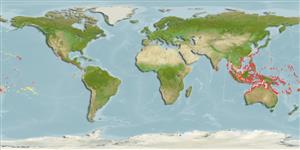分类 / Names
俗名 | 同种异名 | Catalog of Fishes(属, 种) | ITIS | CoL | WoRMS | Cloffa
Teleostei >
Ovalentaria/misc (Various families in series Ovalentaria) >
Pseudochromidae (Dottybacks) > Pseudochrominae
Etymology: Pseudochromis: Greek, pseudes = false + Greek, chromis = a fish, perhaps a perch (Ref. 45335).
More on author: Bleeker.
Environment: milieu / climate zone / depth range / distribution range
生态学
海洋 礁区鱼类; 深度上下限 0 - 30 m (Ref. 37816), usually 0 - 20 m (Ref. 27115). 热带; 30°N - 24°S
Western Pacific: Peninsular Malaysia to Hong Kong and the Ryukyu Islands, south to Western Australia, and east to Vanuatu and the Gilbert Islands. Replaced by an undescribed species at Fiji and Tonga and Pseudochromis coccinicauda in the Indian Ocean (Ref. 37816).
西太平洋: 到香港与琉球群岛的马来半岛,南至西澳大利亚, 而且东至万那度与吉柏特岛。 在印度洋的斐济与东加与 红尾拟雀鲷〔Pseudochromis coccinicauda〕 被一个未描述的种取代了。 (参考文献 37816)
大小 / 重量 / 年龄
Maturity: Lm ? range ? - ? cm
Max length : 6.2 cm TL 雄鱼/尚未辨别雌雄; (Ref. 90102)
背棘 (总数): 3; 背的软条 (总数): 21-23; 臀棘 3; 臀鳍软条: 12 - 14. Females sexually dichromatic dottyback are uniformly grey, sometimes becoming yellowish or reddish on the tail (Ref. 37816).
雌性性两色的 dottyback 均匀灰色, 有时变成淡黄色或淡红的尾部之上.(参考文献 37816)
A common but secretive species (Ref. 9710, 48635) found in holes and crevices of exposed outer reef flats and reef margins. Occurs in pairs and feeds on small crabs, isopods, and copepods (Ref. 1602). Usually most abundant in high current or surge areas. Frequently enters the aquarium fish trade and has been bred in captivity (Ref. 37748). Sometimes solitary (Ref 90102).
一种常见的但是躲躲藏藏的种 (参考文献 9710,48635) 发现于裸露外礁平台的洞与裂隙与礁区边缘了。 成对出现并且吃小的螃蟹,等足目动物与桡脚类的动物.(参考文献 1602) 通常最丰富在海强烈流或涌浪的区域。 时常进入水族馆鱼贸易而且已经被驯养繁殖。 (参考文献 37748)
Life cycle and mating behavior
成熟度 | 繁殖 | 产卵场 | 卵 | 孕卵数 | 仔鱼
Bi-directional sex change has been confirmed for this species (Ref. 103751).西太平洋: 到香港与琉球群岛的马来半岛,南至西澳大利亚, 而且东至万那度与吉柏特岛。 在印度洋的斐济与东加与 红尾拟雀鲷〔Pseudochromis coccinicauda〕 被一个未描述的种取代了。 (参考文献 37816)
Myers, R.F., 1991. Micronesian reef fishes. Second Ed. Coral Graphics, Barrigada, Guam. 298 p. (Ref. 1602)
人类利用
水族馆: 商业性
更多信息
参考文献养殖养殖信息品种遗传学Electrophoreses遗传率疾病加工NutrientsMass conversion
合作者照片Stamps, Coins Misc.声音神经毒速度泳型鳃区Otoliths脑重体重比眼睛色素
工具
特别资料
下载 XML
网络资源
Estimates based on models
Preferred temperature (Ref.
123201): 25.1 - 29, mean 27.9 °C (based on 648 cells).
Phylogenetic diversity index (Ref.
82804): PD
50 = 0.5000 [Uniqueness, from 0.5 = low to 2.0 = high].
Bayesian length-weight: a=0.00490 (0.00187 - 0.01281), b=3.11 (2.88 - 3.34), in cm total length, based on LWR estimates for this (Sub)family-body shape (Ref.
93245).
营养阶层 (Ref.
69278): 3.3 ±0.44 se; based on food items.
Fishing Vulnerability (Ref.
59153): Low vulnerability (10 of 100).
Nutrients (Ref.
124155): Calcium = 200 [100, 344] mg/100g; Iron = 0.952 [0.548, 1.633] mg/100g; Protein = 18.3 [17.1, 19.3] %; Omega3 = 0.111 [0.061, 0.202] g/100g; Selenium = 26 [11, 58] μg/100g; VitaminA = 142 [43, 447] μg/100g; Zinc = 2.39 [1.54, 3.48] mg/100g (wet weight);
